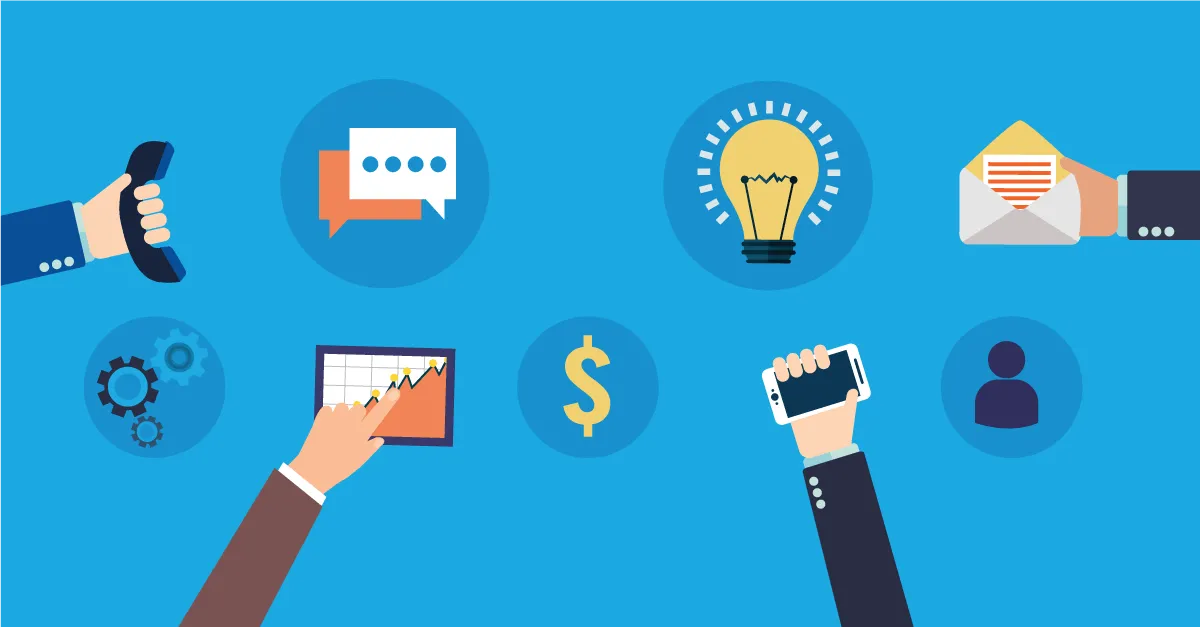Introduction to Closing in Sales

Closing a sale is not just an action but a pivotal moment in the sales process. It's where strategy, technique, and interpersonal skills converge to convert prospects into customers. Understanding and mastering effective sales closing techniques can dramatically increase your success rate. Here’s why it’s crucial:
Statistics Highlighting the Importance of Effective Closing:
- 44% of sales reps give up after one rejection, but the best sales closes often happen after several objections have been overcome.
- Companies that provide ongoing training to their sales teams, including advanced sales closing techniques, see a 50% higher net sales per employee.
- 70% of successful sales involve deliberate use of well-chosen closing techniques tailored to the prospect's unique needs and pain points.
- Only 30% of all sales go to the first vendor to respond, but the vendor who can best close the sale wins, regardless of timing.
15 Best Sales Closing Techniques

Here's a list of 15 effective sales closing techniques that can help sales professionals close deals more efficiently:
The Assumptive Close
The Assumptive Close is built on the premise that the salesperson believes the customer has already decided to purchase. It’s characterized by the use of language that assumes the sale is completed, thereby subtly encouraging the customer to proceed to the transaction phase without overtly asking for the decision.
Examples: A sales rep might say, "Would you prefer delivery on Wednesday or Friday?" instead of asking if the customer wishes to buy the product. This technique smoothly transitions into the logistics of fulfilling the sale, bypassing direct decision-making pressure on the customer.
Why It Works: It works because it removes the pressure-filled moment of decision from the customer, making the purchasing process feel like a natural next step. Additionally, it capitalizes on human psychology's commitment and consistency principles, where individuals feel compelled to act consistently with what they perceive to be an already-decided matter.
How to Make It Work:
- Confidence is key: You must display confidence and assume that the customer is ready to proceed.
- Listen actively: Ensure you've addressed all customer needs and objections before using this close.
- Smooth transition: Seamlessly integrate the close into conversation to ensure it does not come off as presumptuous.
When to Use It: This close is most effective when the customer has shown clear signs of interest and there are no unresolved objections. It’s particularly useful in retail environments or in situations where buyer signals suggest readiness to buy.
The Now or Never Close
This technique creates a sense of urgency, suggesting that failing to act immediately might result in missing out on the opportunity. It often involves limited-time offers, exclusive deals, or looming deadlines.
Examples: A salesperson might say, "This is the last one at this price," or "If you sign up today, you’ll get an additional 15% off."
Why It Works: The Now or Never Close taps into the fear of missing out (FOMO). Customers are motivated by the possibility of loss, making them more likely to commit quickly to avoid missing out.
How to Make It Work:
- Genuine scarcity: Ensure that the urgency or scarcity is real to maintain credibility.
- Highlight exclusivity: Emphasize the uniqueness of the offer.
- Immediate incentive: Combine this close with an immediate benefit for acting now.
When to Use It: It’s most effective in competitive markets where identical products or services are available and customers might be comparing options. Also, it works well when the product stock is low or when special promotions are truly time-sensitive.
The Summary Close
The Summary Close involves summarizing all major benefits and agreements made during the sales discussion, reaffirming the value the product or service brings to the customer. It helps consolidate the decision-making process by reiterating the key points.
Examples: After a sales pitch, a salesperson might recap, "So, with our product, you'll get A, B, and C benefits, all within the budget we discussed. Shall we go ahead and finalize the order?"
Why It Works: It reminds the customer of the value and benefits discussed, consolidating all positive points into one clear picture. This helps overcome last-minute resistance by reinforcing the decision logically and emotionally.
How to Make It Work:
- Comprehensive recap: Make sure to touch on all the benefits and concerns discussed.
- Customize the summary: Tailor the summary to the priorities and values of the customer.
- Clear next steps: End the summary with a clear call to action.
When to Use It: This technique is most beneficial when a lot of information has been discussed, especially with complex products or services. It’s also helpful when the customer needs a final nudge to visualize the overall value.
The Incentive Close
The Incentive Close involves offering the customer a special incentive, such as a discount, additional service, or product upgrade, to make the purchase decision more attractive and urgent. This technique leverages the added value to motivate an immediate sale.
Examples: A sales rep might say, "If you decide to purchase today, I can offer you an additional 10% discount or throw in an extended warranty at no extra cost."
Why It Works: It taps into the customer's desire to get more value for their money. By presenting an exclusive benefit that is contingent on immediate action, it creates a compelling reason for the customer to move forward with the purchase.
How to Make It Work:
- Timely offers: The incentive should be introduced at the right moment, usually after the customer has shown interest but is hesitating to make a final decision.
- Relevance: Ensure the incentive aligns with the customer’s interests or needs.
- Limit availability: Clearly state that the offer is available for a limited time or in limited quantities to enhance urgency.
When to Use It: This close is most effective when you sense hesitation due to price or when the customer is deciding between similar offerings from competitors. It’s also useful in end-of-quarter or end-of-year sales pushes.
The Sharp Angle Close
The Sharp Angle Close is used when a customer requests a concession or additional feature. Instead of simply agreeing, the salesperson agrees conditionally, requesting the close in exchange. This technique turns objections into closing opportunities.
Examples: If a customer asks for a discount or additional feature, the sales rep responds with, "If I can do that for you, will you sign the purchase agreement today?"
Why It Works: This close directly leverages the customer's request as a bargaining chip. It positions the salesperson as accommodating but also moves the negotiation towards a definitive conclusion.
How to Make It Work:
- Prepare to negotiate: Be ready with predefined concessions you can offer that are still profitable.
- Be direct: Clearly link the concession to the closure of the sale.
- Act quickly: This close works best when done swiftly and decisively.
When to Use It: It’s effective when dealing with clients who are negotiation-savvy and likely to appreciate quick, quid-pro-quo bargaining. It’s particularly useful in B2B sales where negotiations are common.
The Question Close
The Question Close involves asking the prospect a question that naturally leads to a positive conclusion about the purchase. It's designed to make the customer articulate their acceptance of the deal, making the close a natural progression rather than a hard sell.
Examples: After a presentation, the salesperson might ask, "Does what I've shown you meet your needs for X and Y?" or "Can you see how this solution would be beneficial in your situation?"
Why It Works: It encourages the customer to think through the decision positively and confirm aloud their readiness to proceed. It's a non-aggressive way to lead the customer towards closure by making them part of the decision process actively.
How to Make It Work:
- Ask open-ended questions: These should guide the customer to reflect on the benefits and how the product or service solves their problem.
- Listen carefully: Use the customer’s responses to tailor your final pitch or to resolve any last-minute objections.
- Create a natural progression: Questions should build logically towards the sale, making the closing step feel like a natural conclusion.
When to Use It: This technique works best when a customer seems nearly convinced but just needs a slight nudge to verbalize their decision. It’s particularly useful in consultative sales environments where trust and relationship are crucial.
The Takeaway Close
The Takeaway Close involves seemingly withdrawing the offer or suggesting the product might be too advanced or unnecessary for the prospect. This reverse psychology motivates the customer to want what they might lose.
Examples: A sales rep might say, "Based on your current needs and budget, perhaps this high-end model might be more than what you require. Let’s consider a more basic version instead."
Why It Works: This technique plays on the human tendency to desire what is scarce or potentially unavailable. It triggers a fear of missing out and often leads the customer to reconsider and express a stronger interest in the initial offer.
How to Make It Work:
- Use sparingly and ethically: Ensure that it doesn’t come off as manipulative.
- Tailor to customer needs: Only use this close if you genuinely believe the product might be a stretch for the customer.
- Ready for a pivot: Be prepared to revert to discussing the original product if the customer shows renewed interest.
When to Use It: Ideal for use when a customer hesitates after the price is revealed or seems overwhelmed by the product’s features. It helps in filtering genuine interest from casual inquiries.
The Soft Close
The Soft Close is a low-pressure technique that involves suggesting a non-committal action that leads the prospect closer to the final purchase, such as agreeing to a trial or a demo, rather than a full purchase.
Examples: "Would you like to start with a free trial to see how it works for you?" or "Can we schedule a demo next week to explore how this fits into your workflow?"
Why It Works: It reduces the pressure associated with a big commitment, allowing the prospect to make a smaller, less daunting decision. This can lead to a more substantial commitment later as the customer becomes more comfortable and convinced of the value.
How to Make It Work:
- Offer options that require less commitment: Free trials, demos, or sample products.
- Emphasize flexibility: Make it clear that the customer is not locked into a decision.
- Focus on relationship-building: Use this close as a way to nurture a longer-term relationship.
When to Use It: This is effective in complex sales, where decisions are significant and the buyer may need more time to commit. It’s also suitable for new markets or with new customers who are not familiar with the product or service.
The Testimonial Close
The Testimonial Close leverages positive statements from satisfied customers to validate the product or service and reduce the prospect's hesitation about making a purchase decision.
Examples: "You know, I just heard back from another client in your industry last week. They mentioned how much our solution has helped them increase their efficiency. I can share their case study if you like."
Why It Works: Testimonials serve as social proof, significantly influencing decision-making by showcasing real-world successes and building trust through the experiences of others.
How to Make It Work:
- Use relevant testimonials: Share stories and examples that resonate with the specific needs and context of the prospect.
- Highlight key outcomes: Focus on results in the testimonials that align with what the prospect hopes to achieve.
- Incorporate a variety of sources: Use testimonials from individuals, case studies, and data points where possible.
When to Use It: Especially useful when dealing with skeptical customers or in industries where proof of effectiveness and ROI is critical. It can also be impactful in competitive scenarios where you need to differentiate your product or service clearly.
The Alternative Choice Close
The Alternative Choice Close involves offering the prospect two choices, both of which lead to a sale. This technique subtly shifts the focus from whether to buy to how to buy.
Examples: A sales representative might say, "Would you prefer the standard package or the premium one with additional features?" or "Do you want to start the service from the beginning of next month or later this week?"
Why It Works: It assumes the sale in a non-threatening way and reduces the mental burden of making a decision by providing controlled options. It’s based on the psychological concept that people find it easier to decide between options rather than to make a binary choice of yes or no.
How to Make It Work:
- Present well-defined options: Ensure both choices are attractive but cater to slightly different needs or preferences.
- Limit the choices: Too many options can overwhelm the prospect, so typically, two or three choices are ideal.
- Highlight differences: Clearly articulate the benefits of each option to help the customer make an informed decision.
When to Use It: This technique is particularly effective in closing deals where the prospect has shown interest but seems hesitant about making a final decision. It's suitable for products or services with different levels or packages.
The Balance Sheet Close
The Balance Sheet Close, often used in more complex or high-stake sales environments, involves drawing up a pros and cons list of making the purchase, helping the customer visualize the decision's advantages and disadvantages.
Examples: A salesperson might draw a literal or figurative balance sheet during a meeting and ask, "Let's list the pros and cons of implementing this solution to see how it measures up."
Why It Works: This technique helps in breaking down the buyer’s decision-making process into simpler, smaller components, making it easier to manage and understand. It appeals to the logical side of decision-making, often tipping the scale by visually emphasizing the pros over the cons.
How to Make It Work:
- Be honest and comprehensive: Include genuine cons to build credibility.
- Focus on mitigating cons: Prepare responses that help minimize the impact of the cons listed.
- Encourage participation: Let the prospect contribute to the list to increase their engagement and buy-in.
When to Use It: Ideal for use when a prospect is analytical or shows concern about potential risks or downsides. It’s also effective in industries where purchases have significant financial or operational implications.
The Puppy Dog Close
Based on the idea of “try before you buy,” the Puppy Dog Close involves letting the prospect use the product or service on a trial basis with the option to return it if not satisfied. The name comes from the notion that if someone takes a puppy home, they’re unlikely to return it because they’ve become attached.
Examples: "If you're not sure about the annual subscription, how about we set you up with a one-month trial? If it doesn’t work for you, you can cancel it with no obligations."
Why It Works: This close reduces the fear of commitment as the prospect feels there is minimal risk involved. It relies on the customer forming an emotional or habitual attachment to the product during the trial period.
How to Make It Work:
- Ensure a smooth trial experience: The product or service must perform flawlessly during the trial to convert the trial into a sale.
- Follow up during the trial: Engage with the customer to solve any issues and highlight the product's value.
- Make transitioning easy: Ensure that turning the trial into a purchase is an easy and seamless process for the customer.
When to Use It: This close works best with products or services that the customer can experience firsthand, such as software, vehicles, or membership services. It's particularly effective when there is confidence that the product’s value will become evident upon use.
The Fear of Missing Out (FOMO) Close
The FOMO Close leverages the psychological fear of missing out on a good deal or opportunity. It's effective because it creates urgency and compels the prospect to make a quick decision to avoid feeling left out.
Examples: "This offer is available for today only," or "We've only got three units left at this price, and they're going fast."
Why It Works: Humans naturally want to belong and have what others have, especially if it seems to be in limited supply. By creating a sense of scarcity and urgency, this close taps directly into that psychological trigger.
How to Make It Work:
- Create genuine scarcity: The scarcity should be real, or it could backfire if seen as manipulative.
- Highlight popularity: Emphasize how others are making the most of this opportunity, which adds social proof to the urgency.
- Be specific about the limitations: Whether it’s a time-bound offer or limited stock, clear specifics help solidify the urgency.
When to Use It: Ideal for use in situations where the product or service is in high demand, or for promotional offers. It works well in both consumer and B2B contexts where decisions need to be accelerated.
The Thermometer Close
This close involves asking the prospect to rate their interest or readiness to buy on a scale, typically from 1 to 10. It helps in gauging the temperature of the prospect's decision stage and addressing any lingering hesitations directly.
Examples: "On a scale from 1 to 10, how ready are you to proceed with this purchase?" Following their answer, you can ask, "What would it take to move you from a 6 to a 10?"
Why It Works: This technique helps uncover hidden objections without direct confrontation and allows the salesperson to tailor their responses to the prospect’s specific concerns or needs.
How to Make It Work:
- Follow up effectively: Depending on their response, provide information, reassurance, or solutions to push the number closer to 10.
- Use it as a discovery tool: This close isn’t just about pushing the sale; it’s about genuinely understanding and solving the prospect's reservations.
When to Use It: It’s most effective in detailed consultations or longer sales cycle where the prospect’s commitment level needs to be assessed before the final pitch. It's particularly useful in industries like automotive or real estate, where the purchase decision is significant.
The Ben Franklin Close
Named after Benjamin Franklin, who famously made decisions by listing pros and cons, this close involves helping the prospect weigh the advantages and disadvantages of the purchase to logically justify the decision.
Examples: "Let’s list all the benefits you’ll gain from using our service, and any drawbacks you foresee. This way, we can see if the advantages outweigh the cons."
Why It Works: This close appeals to analytical thinkers who prefer making informed, logical decisions. It helps break down emotional barriers by focusing on rational analysis.
How to Make It Work:
- Be prepared with data: Have all necessary information on hand to substantiate the benefits.
- Acknowledge cons: Be honest about potential downsides but ready with counterpoints that mitigate these issues.
- Guide the analysis: Help the prospect see how the pros outweigh the cons, subtly steering the decision toward a purchase.
When to Use It: This technique is particularly effective with prospects who are detail-oriented or skeptical. It works well in high-value B2B sales, where decisions are scrutinized closely and must be justified logically to other stakeholders.
Exploring the Psychology Behind Successful Sales Closing Technique

Understanding the psychological underpinnings of effective sales techniques can dramatically enhance a salesperson's ability to close deals. This involves more than just presenting information and asking for business; it requires engaging with the prospect's emotions, thought processes, and decision-making mechanisms.
Here’s a detailed look into the psychology behind successful sales closing techniques, including key concepts and strategies for leveraging human behavior to secure sales.
1. Principle of Commitment and Consistency
People strive for consistency in their beliefs and actions. Once a prospect verbally agrees to something, they are more likely to follow through with it to maintain consistency. This is why techniques like The Assumptive Close are effective.
By framing statements that assume the sale is already decided upon, salespeople can subtly encourage prospects to act consistently with a commitment they feel they have made, effectively moving them closer to signing on the dotted line.
2. Social Proof
Human beings are social creatures influenced by the actions and approvals of others. Techniques like The Testimonial Close, a common sales closing technique, leverage this by showing prospects that other people—especially those they can identify with—have made similar decisions and are happy with the results.
This reduces the perceived risk of the decision and increases trust in the product and the salesperson.
3. Scarcity and Urgency
The Fear of Missing Out (FOMO) is a powerful motivator. When a product or opportunity seems scarce or time-limited, the desire to acquire it increases.
Techniques like The Now or Never Close make use of this by creating urgency. This approach taps into the prospect’s fear of loss, making the opportunity to buy more attractive and pressing, urging them to close a sale.
4. Authority
People respect authority and are more likely to follow suggestions or directions from an authority figure.
Demonstrating expertise and confidence, or using The Expert Close, where the salesperson showcases their knowledge or cites authoritative sources, can significantly influence the prospect’s decision-making process throughout the sales cycle.
5. Liking
Prospects are more likely to buy from someone they like. Building rapport and demonstrating empathy are crucial.
Techniques that involve personal connection, such as The Relationship Close, where the salesperson establishes a bond based on shared interests, experiences, or pains, can lead to more successful closures.
6. Loss Aversion
This psychological principle suggests that the pain of losing is more powerful than the pleasure of gaining something of equivalent value.
The Takeaway Close plays on this by suggesting the prospect might not be able to obtain the product, which could make the prospect more eager to secure it before it’s too late.
7. Cognitive Dissonance
This occurs when a person holds conflicting beliefs or behaviors. A skilled salesperson can navigate this by aligning the product's benefits with the prospect’s self-image and goals, thereby minimizing dissonance.
The Balance Sheet Close, where pros and cons are weighed, can help the prospect rationalize the purchase as the right decision, aligning their actions with their self-concept.
8. Reciprocity
If someone does something for us, we naturally want to return the favor. The Incentive Close, which offers the prospect something extra, taps into this desire to reciprocate the perceived goodwill by agreeing to the sales
How to Address Common Sales Objections

Addressing sales objections effectively is essential for navigating through complex sales conversations and utilizing strategic closing strategies. Here's a detailed guide on how to recognize and overcome typical barriers using common sales closing techniques, modern sales closing techniques, and tailored approaches that focus not just on the product but on comprehensive solutions.
Understanding the Nature of Objections
Sales objections are barriers expressed by prospects that can hinder your ability to close a sale. These typically stem from:
- Need: The prospect does not perceive the need or relevance of the product.
- Authority: The individual you are speaking with may not be the decision-maker.
- Money: The product or service is seen as too expensive.
- Urgency: There is no immediate reason for the prospect to act swiftly.
- Trust: There's a lack of trust in the product or the company.
Strategies for Addressing Common Sales Objections
1. Clarify and Question
Start by clarifying to ensure you've understood the objection correctly. Follow up with specific questions to delve deeper, helping uncover underlying issues such as the prospect's pain points.
Example: If a prospect comments on the price, ask, "What budget constraints are you working within?" or "How do you evaluate the cost relative to the benefits?"
2. Empathize and Respond
Empathizing with the prospect's concerns is crucial. Respond by addressing these concerns using data, testimonials, or demonstrations that can help alleviate doubts, leveraging closing sales techniques that build credibility and reassurance.
Example: Address trust issues by saying, "I understand your concerns. Let me show you how similar businesses achieved significant improvements with our solution."
3. Reframe the Objection
Use modern sales closing techniques to reframe objections into advantages. This approach changes the prospect’s perspective by emphasizing benefits they may have overlooked.
Example: If the objection is price, you might illustrate, "While the initial cost is higher, our product reduces overall expenses by 20% annually, providing a higher long-term value."
4. Utilize Social Proof
Social proof can be a powerful tool in overcoming hesitations. Share success stories and data from satisfied customers who faced similar challenges, especially those within the same industry or demographic.
Example: "Look at how [Comparable Company] addressed these very challenges successfully with our solution..."
5. Offer Assurances
Minimize perceived risks by offering guarantees or trial periods. This can help in overcoming objections related to the fear of investment and commitment.
Example: "Try our service for a month. If it doesn’t meet your expectations, we offer a no-questions-asked refund."
6. Isolate the Objection
Determine if the expressed concern is the only barrier. This helps focus the conversation on clearing that specific hurdle using targeted closing strategies.
Example: "Assuming we can find a way around this issue, is there anything else that would prevent you from moving forward?"
7. Leverage the Bandwagon Effect
The bandwagon effect can influence decisions. Show that many others are making the decision to adopt, which can encourage undecided prospects to act.
Example: "Numerous industry leaders are already seeing significant benefits from switching to our technology. Staying competitive in today’s market often requires such forward-thinking decisions."
Post-Close Strategies for Your Sales Process
The sales process doesn't end once the deal is sealed. Post-close strategies are crucial for ensuring customer satisfaction, fostering long-term relationships, and setting the stage for future opportunities. Effective post-close activities can turn a one-time buyer into a loyal customer and even a brand advocate. Here’s how to enhance your sales process with impactful post-close strategies.
1. Follow-Up Communication
Immediate follow-up after closing a deal is essential. It reassures the customer that they’ve made the right decision, and it demonstrates your commitment to their satisfaction.
Key Actions:
- Send a thank-you note or email acknowledging their purchase and expressing appreciation.
- Schedule a follow-up call or meeting to ensure they are satisfied with the product or service and to address any initial questions or concerns.
2. Onboarding and Education
Particularly for complex products or services, proper onboarding is key to customer satisfaction and retention.
Key Actions:
- Provide comprehensive training sessions, tutorials, or resources that help the customer understand and use your product effectively.
- Offer easily accessible customer support to assist with any technical issues or learning curves.
3. Request Feedback
Feedback is invaluable for understanding customer satisfaction and areas needing improvement. It also shows customers that their opinions are valued and considered.
Key Actions:
- Conduct surveys or request feedback through direct communication.
- Use this feedback to refine your product and customer service, demonstrating to customers that their input leads to real changes.
4. Engage Regularly
Maintaining regular contact with customers keeps your brand top of mind and helps build a strong, ongoing relationship.
Key Actions:
- Send regular updates about new features, products, or services.
- Share relevant content such as blogs, case studies, or newsletters that add value beyond the initial purchase.
5. Loyalty Programs and Incentives
Loyalty programs encourage repeat business and can turn a satisfied customer into a loyal one.
Key Actions:
- Implement a rewards program that offers discounts, special offers, or other perks for repeat customers.
- Consider referral incentives that encourage customers to spread the word about your product or service.
6. Cross-Selling and Upselling
Once a customer is comfortable and satisfied with your initial offering, they may be open to other products or services you provide.
Key Actions:
- Identify customer needs that align with other offerings.
- Approach upselling and cross-selling with a focus on how these additional products or services provide added value.
7. Building a Community
Creating a community around your brand can enhance customer loyalty and encourage a deeper connection with your product or service.
Key Actions:
- Invite customers to join exclusive forums or social media groups.
- Organize or sponsor events that bring customers together and foster a sense of community.
8. Continued Analysis and Improvement
Continuously analyze the effectiveness of your post-sale engagement. Use data-driven insights to optimize your strategies and ensure they are delivering real value to your customers.
Key Actions:
- Monitor customer retention rates, repeat purchase behavior, and engagement metrics.
- Regularly review and adjust your post-close strategies to better meet customer needs and expectations.
Concluding Thoughts
In conclusion, mastering the 15 best closing techniques in sales is not just about perfecting the art of persuasion or manipulation of the product itself; it's about enhancing the entire customer experience from the initial contact to post-sale interactions. Each technique, from the Assumptive Close to the more empathetic Testimonial Close, serves to align the sales process more closely with the customer's needs, expectations, and psychological triggers.
This approach ensures that the sales strategy is comprehensive, addressing not just the product but also the broader context of the customer's desires and pain points. As you implement these techniques, remember that the true art of closing is about creating value that resonates with the customer, fostering trust, and building long-lasting relationships that extend beyond the initial sale.





.jpg)

.jpg)
